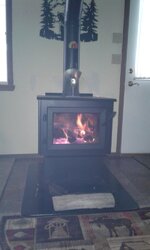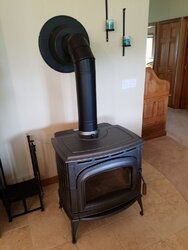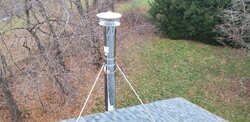Ask BK about the OAK. I would think very possibly it could be a advantage in your situation to reduce/eliminate any competition for makeup air in a questionable draft situation. Maybe?
Do you get the creo smell without the fans running?
When you damp down are you going down just enough to extinguish flame? Starting with this (just below active flame) setting would be a good place to start for figuring your setup/configurations sweet spot (no stink/slow burn).
Can you pull the probe and cover/seal the hole after getting up to cruising temp/setting? Might eliminate that spot as your smell producer. Easy test perhaps?
I have had the best performance (smell free) by engaging the cat when appropriate according to the probe and running with the stat wide open for up to a half hour before turning it down just below active flame (3:30 position for my setup/draw, roughly). It looks like a waste of fuel while burning wide open but really does not seem to be. Tough to be disciplined enough to watch it burn hot for up to a half hour! Good for your pipe cleanliness/health and also for setting up the fresh load for a low burn. If very cold I can turn it down a bit more (3:00 maybe a tic less) to reduce the speed of my burn/wood melt! Any setting less than 2:45 will produce the smell and begin to stall my cat. All my setup can handle.
The last thing that really affected my setup for producing the smell is wet fuel. Mostly if trying to run low/slow to quickly on wet fuel. Nasty!
Your setup will require a custom procedure/setting that does not mirror anyone else's exactly. Something we all learn over time. Apologize if I am reiterating procedures/ideas you have already tried. Don't give up. This is likely a procedural issue you can work through. Good luck!
Do you get the creo smell without the fans running?
When you damp down are you going down just enough to extinguish flame? Starting with this (just below active flame) setting would be a good place to start for figuring your setup/configurations sweet spot (no stink/slow burn).
Can you pull the probe and cover/seal the hole after getting up to cruising temp/setting? Might eliminate that spot as your smell producer. Easy test perhaps?
I have had the best performance (smell free) by engaging the cat when appropriate according to the probe and running with the stat wide open for up to a half hour before turning it down just below active flame (3:30 position for my setup/draw, roughly). It looks like a waste of fuel while burning wide open but really does not seem to be. Tough to be disciplined enough to watch it burn hot for up to a half hour! Good for your pipe cleanliness/health and also for setting up the fresh load for a low burn. If very cold I can turn it down a bit more (3:00 maybe a tic less) to reduce the speed of my burn/wood melt! Any setting less than 2:45 will produce the smell and begin to stall my cat. All my setup can handle.
The last thing that really affected my setup for producing the smell is wet fuel. Mostly if trying to run low/slow to quickly on wet fuel. Nasty!
Your setup will require a custom procedure/setting that does not mirror anyone else's exactly. Something we all learn over time. Apologize if I am reiterating procedures/ideas you have already tried. Don't give up. This is likely a procedural issue you can work through. Good luck!





 Was the air wide open? How long was it going to be before you planned to get back to check the stove?
Was the air wide open? How long was it going to be before you planned to get back to check the stove?